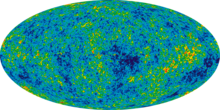History
In the 13th century, Siger of Brabant authored the thesis The Eternity of the World, which argued that there was no first man, and no first specimen of any particular: the physical universe is thus without any first beginning, and therefore eternal. Siger's views were condemned by the Pope in 1277.

Siger of Brabant was a 13th-century philosopher from the southern Low Countries who was an important proponent of Averroism. He was considered a radical by the conservative members of the Roman Catholic Church, but it is suggested that he played as important a role as his contemporary Thomas Aquinas in the shaping of Western attitudes towards faith and reason.

The Condemnations at the medieval University of Paris were enacted to restrict certain teachings as being heretical. These included a number of medieval theological teachings, but most importantly the physical treatises of Aristotle. The investigations of these teachings were conducted by the Bishops of Paris. The Condemnations of 1277 are traditionally linked to an investigation requested by Pope John XXI, although whether he actually supported drawing up a list of condemnations is unclear.
Cosmological expansion was originally discovered through observations by Edwin Hubble. Theoretical calculations also showed that the static universe as modeled by Einstein (1917) was unstable. The modern Big Bang theory is one in which the universe has a finite age and has evolved over time through cooling, expansion, and the formation of structures through gravitational collapse.

Edwin Powell Hubble was an American astronomer. He played a crucial role in establishing the fields of extragalactic astronomy and observational cosmology and is regarded as one of the most important astronomers of all time.

A static universe, also referred to as a "stationary" or "infinite" or "static infinite" universe, is a cosmological model in which the universe is both spatially infinite and temporally infinite, and space is neither expanding nor contracting. Such a universe does not have so-called spatial curvature; that is to say that it is 'flat' or Euclidean. A static infinite universe was first proposed by Thomas Digges.
The steady state model asserts that although the universe is expanding, it nevertheless does not change its appearance over time (the perfect cosmological principle); the universe has no beginning and no end. This requires that matter be continually created in order to keep the universe's density from decreasing. Influential papers on steady state cosmologies were published by Hermann Bondi, Thomas Gold, and Fred Hoyle in 1948. [3] [4]
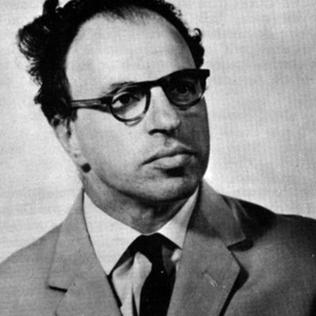
Sir Hermann Bondi was an Anglo-Austrian mathematician and cosmologist.
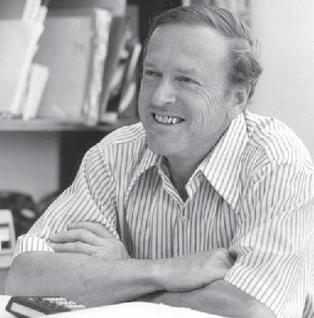
Thomas Gold was an Austrian-born astrophysicist, a professor of astronomy at Cornell University, a member of the U.S. National Academy of Sciences, and a Fellow of the Royal Society (London). Gold was one of three young Cambridge scientists who in 1948 proposed the now mostly abandoned 'steady state' hypothesis of the universe. Gold's work crossed academic and scientific boundaries, into biophysics, astronomy, aerospace engineering, and geophysics.

Sir Fred Hoyle FRS was a British astronomer who formulated the theory of stellar nucleosynthesis. He also held controversial stances on other scientific matters—in particular his rejection of the "Big Bang" theory, a term coined by him on BBC radio, and his promotion of panspermia as the origin of life on Earth. He also wrote science fiction novels, short stories and radio plays, and co-authored twelve books with his son, Geoffrey Hoyle.
It is now known that Albert Einstein considered a steady state model of the expanding universe, as indicated in a 1931 manuscript, many years before Hoyle, Bondi and Gold. However, he quickly abandoned the idea. [5]
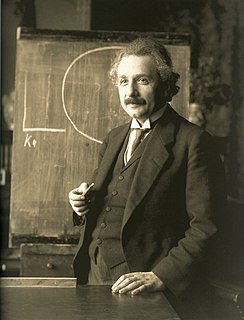
Albert Einstein was a German-born theoretical physicist who developed the theory of relativity, one of the two pillars of modern physics. His work is also known for its influence on the philosophy of science. He is best known to the general public for his mass–energy equivalence formula E = mc2, which has been dubbed "the world's most famous equation". He received the 1921 Nobel Prize in Physics "for his services to theoretical physics, and especially for his discovery of the law of the photoelectric effect", a pivotal step in the development of quantum theory.

In physical cosmology, cosmic inflation, cosmological inflation, or just inflation, is a theory of exponential expansion of space in the early universe. The inflationary epoch lasted from 10−36 seconds after the conjectured Big Bang singularity to sometime between 10−33 and 10−32 seconds after the singularity. Following the inflationary period, the universe continues to expand, but at a less rapid rate.

In physical cosmology, the Copernican principle is an alternative name for the principle of relativity, stating that humans, on the Earth or in the Solar System, are not privileged observers of the universe.

The cosmic microwave background is electromagnetic radiation as a remnant from an early stage of the universe in Big Bang cosmology. In older literature, the CMB is also variously known as cosmic microwave background radiation (CMBR) or "relic radiation". The CMB is a faint cosmic background radiation filling all space that is an important source of data on the early universe because it is the oldest electromagnetic radiation in the universe, dating to the epoch of recombination. With a traditional optical telescope, the space between stars and galaxies is completely dark. However, a sufficiently sensitive radio telescope shows a faint background noise, or glow, almost isotropic, that is not associated with any star, galaxy, or other object. This glow is strongest in the microwave region of the radio spectrum. The accidental discovery of the CMB in 1964 by American radio astronomers Arno Penzias and Robert Wilson was the culmination of work initiated in the 1940s, and earned the discoverers the 1978 Nobel Prize in Physics.

Dark matter is a hypothetical form of matter that is thought to account for approximately 85% of the matter in the universe, and about a quarter of its total energy density. The majority of dark matter is thought to be non-baryonic in nature, possibly being composed of some as-yet undiscovered subatomic particles. Its presence is implied in a variety of astrophysical observations, including gravitational effects that cannot be explained unless more matter is present than can be seen. For this reason, most experts think dark matter to be ubiquitous in the universe and to have had a strong influence on its structure and evolution. Dark matter is called dark because it does not appear to interact with observable electromagnetic radiation, such as light, and is thus invisible to the entire electromagnetic spectrum, making it extremely difficult to detect using usual astronomical equipment.

In astrophysics and physical cosmology, Olbers' paradox, named after the German astronomer Heinrich Wilhelm Olbers (1758–1840), also known as the "dark night sky paradox", is the argument that the darkness of the night sky conflicts with the assumption of an infinite and eternal static universe. The darkness of the night sky is one of the pieces of evidence for a dynamic universe, such as the Big Bang model. In the hypothetical case that the universe is static, homogeneous at a large scale, and populated by an infinite number of stars, then any line of sight from Earth must end at the surface of a star and hence the night sky should be completely illuminated and very bright. This contradicts the observed darkness and non-uniformity of the night.

The ultimate fate of the universe is a topic in physical cosmology, whose theoretical restrictions allow possible scenarios for the evolution and ultimate fate of the universe to be described and evaluated. Based on available observational evidence, deciding the fate and evolution of the universe have now become valid cosmological questions, being beyond the mostly untestable constraints of mythological or theological beliefs. Many possible dark futures have been predicted by rival scientific hypotheses, including that the universe might have existed for a finite and infinite duration, or towards explaining the manner and circumstances of its beginning.

A non-standard cosmology is any physical cosmological model of the universe that was, or still is, proposed as an alternative to the then-current standard model of cosmology. The term non-standard is applied to any theory that does not conform to the scientific consensus. Because the term depends on the prevailing consensus, the meaning of the term changes over time. For example, hot dark matter would not have been considered non-standard in 1990, but would be in 2010. Conversely, a non-zero cosmological constant resulting in an accelerating universe would have been considered non-standard in 1990, but is part of the standard cosmology in 2010.

The discovery of cosmic microwave background radiation constitutes a major development in modern physical cosmology. The cosmic background radiation (CMB) was measured by Andrew McKellar in 1941 at an effective temperature of 2.3 K using CN stellar absorption lines observed by W. S. Adams. Theoretical work around 1950 showed that the need for a CMB for consistency with the simplest relativistic universe models. In 1964, US physicist Arno Penzias and radio-astronomer Robert Woodrow Wilson rediscovered the CMB, estimating its temperature as 3.5 K, as they experimented with the Holmdel Horn Antenna. The new measurements were accepted as important evidence for a hot early Universe and as evidence against the rival steady state theory. In 1978, Penzias and Wilson were awarded the Nobel Prize for Physics for their joint measurement.

Observational cosmology is the study of the structure, the evolution and the origin of the universe through observation, using instruments such as telescopes and cosmic ray detectors.
The source counts distribution of radio-sources from a radio-astronomical survey is the cumulative distribution of the number of sources (N) brighter than a given flux density (S). Because it is usually plotted with the log-log scale, so its distribution is also called as the log N – log S plot. It is one out of a half-dozen cosmological tests that was conceived in the 1930s to check the viability of and compare new cosmological models.

In physical cosmology, structure formation is the formation of galaxies, galaxy clusters and larger structures from small early density fluctuations. The universe, as is now known from observations of the cosmic microwave background radiation, began in a hot, dense, nearly uniform state approximately 13.8 billion years ago. However, looking in the sky today, we see structures on all scales, from stars and planets to galaxies and, on still larger scales, galaxy clusters and sheet-like structures of galaxies separated by enormous voids containing few galaxies. Structure formation attempts to model how these structures formed by gravitational instability of small early density ripples.
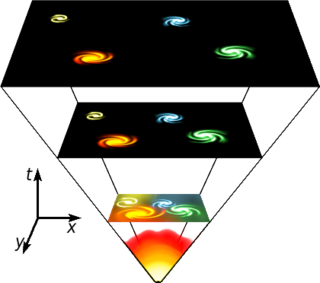
The history of the Big Bang theory began with the Big Bang's development from observations and theoretical considerations. Much of the theoretical work in cosmology now involves extensions and refinements to the basic Big Bang model.
The Hoyle–Narlikar theory of gravity is a Machian and conformal theory of gravity proposed by Fred Hoyle and Jayant Narlikar that originally fits into the quasi steady state model of the universe.
Cold Big Bang is a designation used in cosmology to denote an absolute zero temperature at the beginning of the Universe, instead of a (hot) Big Bang.
The cosmic age problem is a historical problem in astronomy concerning the age of the universe. The problem was that at various times in the 20th century, some objects in the universe were estimated to be older than the time elapsed since the Big Bang, as estimated from measurements of the expansion rate of the universe known as the Hubble constant, denoted H0. (This is more correctly called the Hubble parameter, since it generally varies with time). If so, this would represent a contradiction, since objects such as galaxies, stars and planets could not have existed in the extreme temperatures and densities shortly after the Big Bang.
